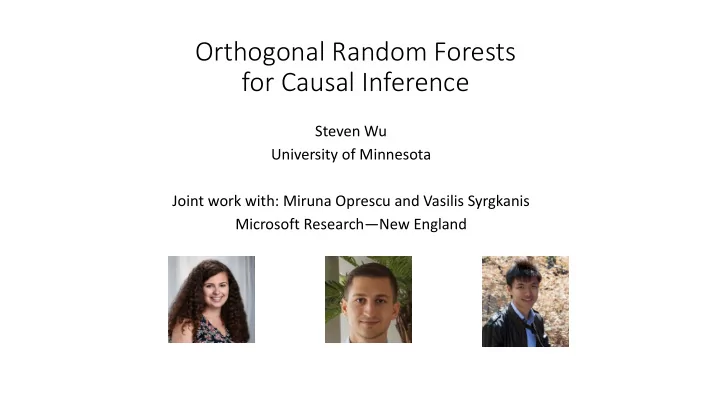

Orthogonal Random Forests for Causal Inference Steven Wu University of Minnesota Joint work with: Miruna Oprescu and Vasilis Syrgkanis Microsoft Research—New England
Motivating examples Dynamic pricing Clinical trials Targeted advertising • Conditional average treatment estimation (CATE) from observational data • Outcome ! " (demand) • Treatment # " (pricing) • Feature $ " that captures heterogeneity (income level) • Confounders % " (other observed variables) Treatment effect Our Goal: CATE estimation ! = ' $, % ⋅ # + + , $, % + - 0 , 1 = 2 ' , $, % $ = 1] # = . , $, % + /
More generally… • In the language of econometrics: Given a target feature ! , find a solution " # (!) to & '((; ", ℎ # (,, -)) , = !] = 0 with score function ' and nuisance function ℎ # • Other examples: non-parametric regression, instrumental variable regression, local maximum likelihood estimation, etc.
Orthogonal Random Forest (ORF) Generalized Random Forest (GRF) Orthogonality (or double ML) [Wager & Athey 2018; Athey et al. 2019] [Neyman1979; Chernozhukov et al. 2017] Method: Method: • Perform two-stage estimation: first • Non-parametric random forest-based estimate nuisance, then estimate target ! " estimation Pros: Pros: • Robust to high-dimensional confounders • Allows more general functions ! " Cons: Cons: • Assumes parametric form ! " • Does not directly handle high-dimensional nuisance functions
Main theoretical results for ORF Accuracy for ORF estimate ! " • Consistency error rate • Asymptotic normality Nuisance estimation procedure • Forest Lasso method that leverages locally sparse structure
Empirical Evalua,on
Orthogonal Random Forests for Causal Inference Poster: Wed Jun 12th @ Pacific Ballroom #195
Recommend
More recommend